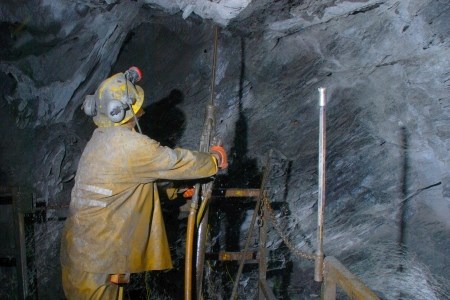The rising demand for new workers in the mining industry is sparking new training and qualification initiatives from companies and organizations operating in Northern Ontario.
One such company is North Bay’s Cementation Canada, which continues to push its wildly successful New Miner Training Program throughout the country, from the Diavik project in Nunavut to the Totten Mine in Sudbury.
Designed for new workers interested in the industry, it has been used to engage, train and hire people who are paid through their learning phase, becoming employees of Cementation as they receive their education. As successful graduates, they go on to work for the company on a full-time basis.
The system has provided such positive results that Cementation has since rolled out the program in various locations throughout Canada, including several Aboriginal and Inuit communities.
“We, as employers, tend to forget how important training is,” said Denis Beaudoin, Cementation’s corporate director of health and safety.
“The only time it comes to our attention is when there’s a boom in the industry and we’re running out of people, so then we say ‘we need to train.’”
The program was first introduced in Sudbury in 2004, where interest was such that 700 people applied for 20 learning slots. Successful applicants were selected based on criteria such as work history, attitude and age.
The program is modular, and spread over a series of thematic sections. Beginning with orientation and mining legislation specific to the province where the training is taking place, the course material then shifts to safety and evacuation procedures, and eventually to ground support and ground control techniques. Final modules focus on the use of explosives, slinging and rigging, underground staging, drilling and introduction to mucking.
Classroom and hands-on training lasts for three months, followed by a nine-month job placement.
This was most recently completed at Newmont Mining’s Hope Bay project in Nunavut. Another round of trainees is slated to begin at Cementation’s newest project, Northgate Mineral’s Young-Davidson Mine in Matachewan, in the coming weeks.
These programs have also brought valuable lessons as staff have analyzed what did and didn’t work with each iteration of the program.
In Sudbury, one of the greatest challenges was retention, as many of the trained workers soon jumped ship to Cementation’s own clients, including Xstrata and Vale.
To date, Cementation’s retention rate sits between 60 and 70 per cent.
Age is also a factor, as those in the 22- to 26-year-old range often hadn’t worked away from home and thus would be more uncomfortable working in the far-flung regions where Cementation sometimes operates.
The age range of 26-35 ensures more maturity and comfort, says Beaudoin.
This disconnect also was a factor for trainees from distant First Nation communities, where the culture means trainees are not prepared to be pulled from their homes and brought to remote fly-in camps.
This has mandated the use of additional adaptation programs and mentorship. Problems also initially arose from some of the systems the company used to acquire funding for the project. Often, applicants are funded by Cementation with some financial support from project partners or government agencies. This funding support has proven to be somewhat problematic, bogging down the selection process with more stringent criteria and providing applicants who were more suited to “funding eligibility” rather than proper attitude and aptitude.
“When we can control the program, we can move much quickly,” said Beaudoin. “Training is expensive, and if you can, look for alternative ways for funding assistance, but you have to be innovative and you have to look at the retention rate you can expect with these trainees.”
Beaudoin’s dedication to bolstering the industry workforce is also evident in his involvement as an advisor with the Mining Industry Human Resources Council (MiHR)’s new Canadian Mining Credentials Program.
Currently being tested on a pilot basis across seven Canadian sites, the program will be rolled out across Canada by mid-2011.
The vision is to allow for official determination of skills and competencies of workers in unrecognized, undesignated occupations to support worker mobility between sectors, provinces, and even from outside the country. It will also allow for more consistent and high-quality training by companies and educational institutions alike, said Barbara Kirby, executive director of MiHR.
MiHR is in the process of creating national occupational standards that will then be used to build a personnel certification program. Training programs that meet or exceed the entry-level requirements for employers can then be properly accredited.
Cementation’s New Miner Training Program is an example of one such program, she said, which is also allowing for the use of the company’s work at the Totten Mine to act as one of MiHR’s test sites.
“The idea will be to have new and experienced workers be able to challenge the certification program through a system that will allow them to demonstrate in the workplace that they know and can show their competency at all the skills required and defined in the occupational standards,” said Kirby. “This will eventually allow for certification of that worker.”
To date, MiHR has developed standards for the skills, competencies and knowledge required of a miner, diamond driller, or minerals processing operator.
The average production miner will work at five to seven mines through the course of their career, and having their skills recognized at these different sites has always been an industry challenge, said Kirby.
What’s more, workers who transition to mining from other industries such as forestry need to have their skills recognized while determining what other skills they need to effectively transfer over.




